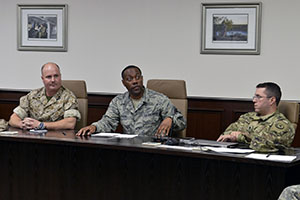Texas Military Department strengthens communication throughout the ranks
Story by: Sgt. Elizabeth Peña
Posted: Sep. 10, 2016
 Texas Guardsmen are broken into working groups to work on separate mission sets. By combining the components, service members were able to discuss issues they saw simultaneously across the force. Eighteen handpicked service members from the Texas Army National Guard, Texas Air National Guard and State Guard, representing each brigade, wing and major command in the Texas Military Department, came together for an inaugural Junior Enlisted Advisory Council at Camp Mabry in Austin, Texas, September 10-11, 2016 to discuss how to bridge gaps within the force. (U.S. Army National Guard photo by Sgt. Elizabeth Pena)
Texas Guardsmen are broken into working groups to work on separate mission sets. By combining the components, service members were able to discuss issues they saw simultaneously across the force. Eighteen handpicked service members from the Texas Army National Guard, Texas Air National Guard and State Guard, representing each brigade, wing and major command in the Texas Military Department, came together for an inaugural Junior Enlisted Advisory Council at Camp Mabry in Austin, Texas, September 10-11, 2016 to discuss how to bridge gaps within the force. (U.S. Army National Guard photo by Sgt. Elizabeth Pena)
AUSTIN, Texas -- Basic military values teach service members to always put the mission first. As those missions are being fulfilled and new policies put in place, leaders must ensure their junior future leaders are not left behind.
Current technology has far surpassed the technology of 20 years ago and these factors present challenges in communicating across generations.
“We are a generation removed from the junior enlisted, who are the bread and butter of our organization,” said Command Sgt. Maj. Mark A. Weedon, Command Senior Enlisted Leader for the Texas Military Department. “So we want to make sure that we have some circular communication from top to bottom.”
Eighteen handpicked service members from the Texas Army National Guard, Texas Air National Guard and State Guard, representing each brigade, wing and major command in the Texas Military Department, came together for an inaugural Junior Enlisted Advisory Council at Camp Mabry in Austin, Texas, September 10-11, 2016 to discuss how to bridge gaps within the force.
“I was picked by my platoon sergeant because he thinks that I would be an asset to this council,” said Texas State Guard Petty Officer William Rogers, with the 3rd Battalion Maritime Regiment. “I feel like I’ve got experience in both federal and state and I can combine those experiences and give my input as someone that’s very senior in age as an E-4 that’s got my life experiences.”
During the council, service members were broken into sections.
“We split the council up into four groups and they each worked on separate mission sets,” said Weedon. “We will be presenting those problem set solutions to the Texas Adjutant General and to the executive council in a couple weeks.”
By combining the components, service members were able to discuss issues they saw simultaneously across the force.
“I saw tremendous similarities,” said Rogers. “Once we got in there and the boundaries came down, it wasn’t State Guard, it wasn’t National Guard, and it wasn’t Air National Guard we were just all soldiers and troops and airmen working together for a cause.”
Through the use of meetings and by providing the opportunity to receive training, network with peers and participate in-group discussions, junior enlisted guardsmen can enhance and support the effective communication of the Texas Military Department strategic vision, mission, and goals.
“I think it’s going to work great,” said Texas Army National Guard Spc. Robert Sanchez, combat engineer with the 836th Sapper Company of the 136th Maneuver Enhancement Brigade. “Command Sgt. Major Weedon has a strong opinion behind everything that we are saying. He is trying to understand what we are saying and put everything into his own words so when he presents it, its what we want but, it’s also at a good standpoint for Col. Chaney and the Texas Adjutant General.”
The guardsmen were directed to go back to their respective units and communicate with other junior service members to gather analysis for the next meeting.
“I got the ability to work with diversity and understand what we need to do to help new airmen or soldiers,” said Airman 1st Class LaChunda Gibbs, supply specialist with the 147th Reconnaissance Wing. “What I’m taking back is the info that we can use to resolve the issues within the military.”
The council is scheduled to meet quarterly, with members rotating out approximately every two years.
“Our Texas Adjutant General is a people person,” said Weedon. “He is probably the biggest advocate in this state for our junior enlisted so when they directly identify issues and make recommendations for solutions, he’s going to listen.”